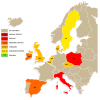The Role of Nutrients in Reducing the Risk for Noncommunicable Diseases during Aging
- PMID: 30621135
- PMCID: PMC6356205
- DOI: 10.3390/nu11010085
The Role of Nutrients in Reducing the Risk for Noncommunicable Diseases during Aging
Abstract
An increasing aging population worldwide accounts for a growing share of noncommunicable diseases (NCDs) of the overall social and economic burden. Dietary and nutritional approaches are of paramount importance in the management of NCDs. As a result, nutrition programs are increasingly integrated into public health policies. At present, programs aimed at reducing the burden of NCDs have focused mostly on the excess of unhealthy nutrient intakes whereas the importance of optimizing adequate essential and semi-essential nutrient intakes and nutrient-rich diets has received less attention. Surveys indicate that nutrient intakes of the aging population are insufficient to optimally support healthy aging. Vitamin and mineral deficiencies in older adults are related to increased risk of NCDs including fatigue, cardiovascular disease, and cognitive and neuromuscular function impairments. Reviewed literature demonstrates that improving intake for certain nutrients may be important in reducing progress of NCDs such as musculoskeletal disorders, dementia, loss of vision, and cardiometabolic diseases during aging. Current knowledge concerning improving individual nutrient intakes to reduce progression of chronic disease is still emerging with varying effect sizes and levels of evidence. Most pronounced benefits of nutrients were found in participants who had low nutrient intake or status at baseline or who had increased genetic and metabolic needs for that nutrient. Authorities should implement ways to optimize essential nutrient intake as an integral part of their strategies to address NCDs.
Keywords: cardiovascular disease; chronic disease; dementia; eye disorders; musculoskeletal disorders; noncommunicable disease; nutrient inadequacies and deficiencies; nutrient interventions; public health.
Conflict of interest statement
M.J.B. and P.V.D. are employed by DSM Nutritional Products, a manufacturer of vitamins and supplier to the food, dietary supplement, and pharmaceutical industries. M.E. is a former employee of DSM Nutritional Products. There were no other conflicts of interest.
Figures
References
-
- World Health Organization (WHO) Global Health Observatory (GHO) Data, Life Expectancy. [(accessed on 20 September 2018)]; Available online: http://www.who.int/gho/mortality_burden_disease/life_tables/situation_tr...
-
- Troesch B., Biesalski H.K., Bos R., Buskens E., Calder P.C., Saris W.H., Spieldenner J., Verkade H.J., Weber P., Eggersdorfer M. Increased Intake of Foods with High Nutrient Density Can Help to Break the Intergenerational Cycle of Malnutrition and Obesity. Nutrients. 2015;7:6016–6037. doi: 10.3390/nu7075266. - DOI - PMC - PubMed
-
- World Health Organization (WHO) Global Action Plan for the Prevention and Control of NCDs 2013–2020. [(accessed on 3 January 2019)];2018 Available online: https://www.who.int/nmh/publications/ncd-action-plan/en/
-
- United Nations Economic and Social Council (ECOSOC) ECOSOC 2018 Task Force Resolution Urges Partners to Mobilize Resources for the Work of the Task Force. [(accessed on 20 September 2018)]; Available online: http://www.who.int/ncds/un-task-force/events/ecosoc-report-2018/en/
Publication types
MeSH terms
Substances
LinkOut - more resources
Full Text Sources
Medical
Research Materials



